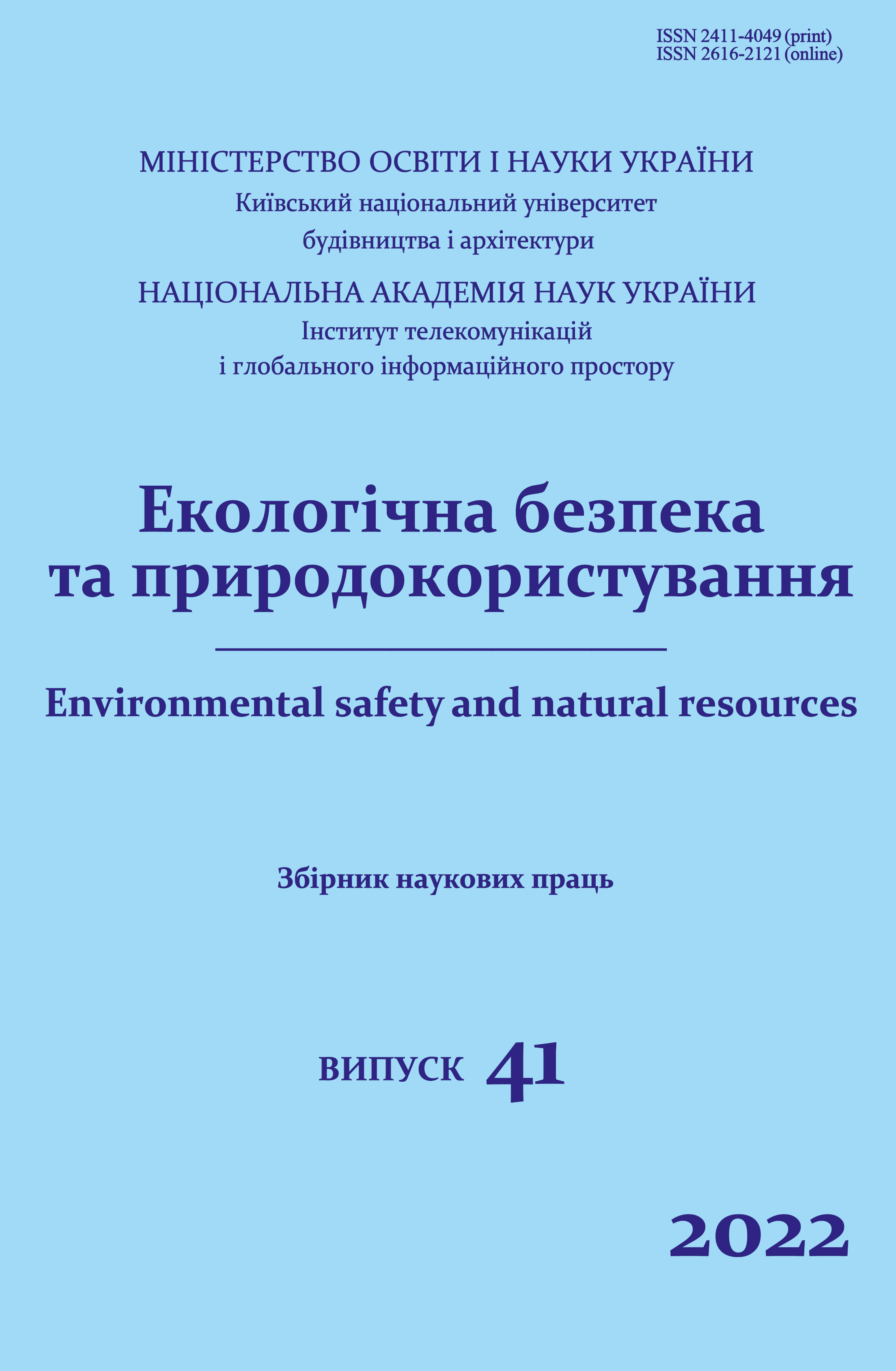Implementation of european regulations of green building in the construction industry of Ukraine
DOI:
https://doi.org/10.32347/2411-4049.2022.1.31-43Keywords:
green building, climate change, urban areas, implementation, adaptationAbstract
Construction is an example of anthropogenic activity that not only harms the environment, but often causes the destruction and even destruction of ecosystems. The threat is posed by all stages of construction from design and survey work to maintenance of the finished building and its disposal at the end of the housing cycle. By creating an additional environmental burden, the construction industry has a negative impact on human health. Instead of natural ecosystems, as a result of construction activities, urban areas are created – a zone of continuous development within the city or urban agglomeration. Whether the urban environment will be comfortable for a person or, on the contrary, a person will feel ecological discomfort depends on the work of architects, builders, and the quality of building materials. The ecological state of cities can be attributed to the global environmental problems of mankind. The desire to reduce the impact on the environment encourages the search for ways to improve, innovative methods, the latest technologies, safe for the environment and human health building materials. Current trends in the implementation of green building standards are promising for overcoming the environmental crisis of cities, and make it possible to reduce the impact of the construction industry on the environment. In order to accelerate the pace of implementation of aspects of "green building" it is necessary to implement European environmental standards in the legislation of Ukraine. The introduction of mandatory environmental certification of buildings at the legislative level (starting with new buildings) is one of the most important steps in this direction. The basis is the already popular and time-tested British international certification system BREEAM, the rating system for energy efficient and environmentally friendly buildings LEED (Leadership in Energy and Environmental Design, USA), or DGNB (Deutsche Gesellschaft für Nachhaltiges Bauen, Germany).
References
Rio Declaration on Environment and Development. Retrieved 10.11.2021 from: https://zakon.rada.gov.ua/laws/show/995_455#Text.
About the Basic principles (strategy) of the state ecological policy of Ukraine for the period till 2030. Retrieved 10.11.2021 from: https://zakon.rada.gov.ua/laws/show/2697-19#Text.
Kryvomaz Т. I., & Savchenko, A. M. (2021). The reducing of construction industry influence on climate change by implementation of green building principles. Environmental Safety and Natural Resources, 37(1), 55–68 [In Ukrainian]. https://doi.org/10.32347/2411-4049.2021.1.55-68.
Torkatyuk, V.I., Weinberg, O.I., & Butnik, S.V. Features of the impact of construction on the environment. Retrieved 12.11.2021 from: http://eprints.kname.edu.ua/29265/1/23.pdf [In Ukrainian].
UN’s Sustainable Development Goals (SDGs). Retrieved 12.11.2021 from: http://un.org/sustainabledevelopment/sustainable-development-goals.
World Green Building Council (WGBC). Retrieved 12.11.2021 from: http://worldgbc.org.
Impact of construction on the environment Retrieved 13.11.2021 from: https://pidru4niki.com/70557/ekologiya/vpliv_budivnitstva_dovkillya.
Tolbatov, A.V., Lvovich, I.Ya., Orlov, N.M., Preobrazhensky, A.P., Choporov, O.N. et al. (2018). Scientific environment of modern man: Economics, Management, Medicine and Pharmacy, Chemistry, Biology, Agriculture, Geography and Geology: monograph. Odessa: Kuprienko SV [In Russian].
Tolbatov, V.A., Lvovich, I.Y., Preobrazhensky, A.P., Chervony, I.F., Choporov, O.N. et al. (2018). Scientific environment of modern man: Technique and technology: monograph. Odessa: Kuprienko SV [In Russian].
Tolbatov, A.V., Verkhovlyuk, A.M., Ivanova, T.N., Kopey, B.V., Tolbatov, V.A. et al. (2018). Innovative science, education, production and transport: Engineering and technology: monograph. Odessa: Kuprienko SV [In Russian].
The benefits of green buildings. Retrieved 20.11.2021 from https://www.worldgbc.org/benefits-green-buildings.
Better Places for People is WorldGBC's global project to support GBCs. Retrieved 10.01.2022 from http://worldgbc.org/better-places-people.
C40 Cities. Retrieved 10.01.2022 from http://c40.org.
Green Building Council of Australia (GBCA). Retrieved 04.01.2022 from new.gbca.org.au.
Houghtona, A., & Castillo-Salgado, C. Analysis of correlations between neighborhood-level vulnerability to climate change and protective green building design strategies: A spatial and ecological analysis. Building and Environment, 168, 106523 [PMC free article].
International Labour Organisation (ILO). Retrieved 12.12.2021 from http://ilo.org.
Shparik, N.Ya. (2014). Problems of implementation of international legal acts in the ecological legislation of Ukraine. Law and Society, 4, 124-130 [In Ukrainian].
Implementation of environmental commitments under deregulation in the European Union. Experience of best practices for Ukraine. Retrieved 11.01.2022 from: webenvironmentalimplementation2018ua.pdf.
Eurobarobemer, 2014. Retrieved 11.01.2022. from: https://ec.europa.eu/commission/presscorner/detail/en/IP_14_2702.
The term green building is meant. What is "green architecture". Design, preparation and construction of land. Retrieved 11.01.2022. from: https://sbk03.ru/uk/termin-zelenoe-stroitelstvo-podrazumevaet-chto-takoe-zelenaya-arhitektura/.
Kulikov, P.M., Zhuravska, N.Y., & Savchenko, A.M. (2020). Modern Possibilities of Management of Technogenic-Natural Systems of Heat-Energy Objects of Industrial and Construction Industry. https://doi.org/10.1007/978-3-030-42939-3_13.
Tkachenko, T. M. (2018). Scientific and methodological bases of increasing the level of ecological safety of urban coenoses by creating energy-efficient technologies of "green" construction (Doctoral dissertation, Kyiv. nat. University of Construction and Architecture) [Abstract]. Retrieved January 24, 2022, from http://www.irbis-nbuv.gov.ua/cgi-bin/irbis_nbuv/cgiirbis_64.exe?Z21ID=&I21DBN=UJRN&P21DBN=UJRN&S21STN=1&S21REF=10&S21FMT=fullwebr&C21COM=S&S21CNR=20&S21P01=0&S21P02=0&S21P03=A=&S21COLORTERMS=1&S21STR=%D0%A2%D0%BA%D0%B0%D1%87%D0%B5%D0%BD%D0%BA%D0%BE%20%D0%A2$ [In Ukrainian].
Association Agreement between Ukraine, of the one part, and the European Union and its Member States, of the other part. Retrieved 24.01.2022. from: http://www.kmu.gov.ua/docs/Agreement/AA_Body_text.pdf.
Savchenko, A. M. (2020). Implementation of EU environmental standards in the legal framework of Ukraine as an environmental protection technology. In First All-Ukrainian Scientific and Practical Conference with International Participation "Ecology. Environment. Energy Saving" dedicated to the 90th anniversary of the National University "Poltava Polytechnic named after Yuri Kondratyuk" (pp. 210-213) Poltava: NUPP [In Ukrainian].
Law of Ukraine "On Principles of Monitoring, Reporting and Verification of Greenhouse Gas Emissions" of December 12, 2019. № 377-IX. Bulletin of the Verkhovna Rada of Ukraine, 2020, № 22, p.150.
Draft Law "On Prevention, Reduction and Control of Industrial Pollution" Retrieved 24.01.2022 from: https://www.kmu.gov.ua/news/uryad-shvaliv-zakonoproekt-pro-zapobigannya-zmenshennya-ta-kontrol-promislovogo-zabrudnennya.
Downloads
Published
How to Cite
Issue
Section
License
Copyright (c) 2022 Savchenko A.M., Tkachenko Т.М.

This work is licensed under a Creative Commons Attribution 4.0 International License.
The journal «Environmental safety and natural resources» works under Creative Commons Attribution 4.0 International (CC BY 4.0).
The licensing policy is compatible with the overwhelming majority of open access and archiving policies.

